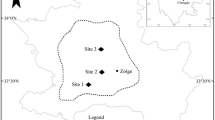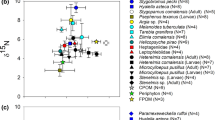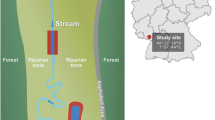Abstract
Although lacustrine food webs have been extensively studied, food webs formed on floating-leaved macrophytes are poorly understood. In recent years, lotus Nelumbo nucifera, which was often seen in shallow waters, has rapidly expanded and covered a significant part of the surface of the eutrophic shallow Lake Izunuma in Japan. We investigated the diet of the semiaquatic spider Alopecosa cinnameopilosa collected from lotus vegetation and the shore, using carbon and nitrogen stable isotopes. We categorized the spiders’ potential diet as aquatic prey (aquatic insects and small fish), terrestrial insects, or semiaquatic leaf beetles (Donacia provostii and Galerucella nipponensis) that forage mainly on floating-leaved macrophytes. In lotus vegetation, A. cinnameopilosa relied mostly on leaf beetles (mean dietary contribution: 57.3% in July and 46.0% in September). On the lake shore, A. cinnameopilosa relied on both leaf beetles (41.0%) and aquatic prey (36.4%) in July, whereas they relied mostly on aquatic prey (83.1%) in September. The difference in diets between sites could reflect differences between sites in the abundance of leaf beetles. Therefore, macrophyte-based food webs that start from lotus or water chestnuts could significantly support semiaquatic spiders on macrophyte vegetation in Lake Izunuma.



Similar content being viewed by others
Data availability
All data generated or analyzed during this study are included in this published article.
References
Akamatsu F, Hideshige T, Okino T (2004) Food source of riparian spiders analyzed by using stable isotope ratios. Ecol Res 19(6):655–662. https://doi.org/10.1111/j.1440-1703.2004.00680.x
Bakker ES, Wood KA, Pagès JF et al (2016) Herbivory on freshwater and marine macrophytes: a review and perspective. Aquat Bot 135:18–36. https://doi.org/10.1016/j.aquabot.2016.04.008
Baxter CV, Fausch KD, Carl Saunders W (2005) Tangled webs: reciprocal flows of invertebrate prey link streams and riparian zones. Freshw Biol 50(2):201–220. https://doi.org/10.1111/j.1365-2427.2004.01328.x
Carpenter SR, Lodge DM (1986) Effects of submersed macrophytes on ecosystem processes. Aquat Bot 26:341–370. https://doi.org/10.1016/0304-3770(86)90031-8
Collier KJ, Bury S, Gibbs M (2002) A stable isotope study of linkages between stream and terrestrial food webs through spider predation. Freshw Biol 47(9):1651–1659. https://doi.org/10.1046/j.1365-2427.2002.00903.x
Cronin G, Wissing KD, Lodge DM (1998) Comparative feeding selectivity of herbivorous insects on water lilies: aquatic vs. semi-terrestrial insects and submersed vs. floating leaves. Freshw Biol 39(2):243–257. https://doi.org/10.1046/j.1365-2427.1998.00279.x
Cunha ER, Thomaz SM, Mormul RP, Cafofo EG, Bonaldo AB (2012) Macrophyte structural complexity influences spider assemblage attributes in wetlands. Wetlands 32(2):369–377. https://doi.org/10.1007/s13157-012-0272-1
DeNiro MJ, Epstein S (1977) Mechanism of carbon isotope fractionation associated with lipid synthesis. Science 197(4300):261–263. https://doi.org/10.1126/science.327543
Doi H (2009) Spatial patterns of autochthonous and allochthonous resources in aquatic food webs. Popul Ecol 51(1):57–64. https://doi.org/10.1007/s10144-008-0127-z
Hayashi M (2004) Revisional study on Japanese members of Donaciinae (Coleoptera: Chrysomelidae). Bull Hoshizaki Green Found 7:29–126
Izunuma-Uchinuma Natural Regeneration Council (2009) Master plan for natural regeneration of Izunuma-Uchinuma. IUNRC, Miyagi Prefecture, Sendai ((in Japanese))
Kawai T, Tanida K (2018) Aquatic insects of Japan: manual with keys and illustrations. Tokai University Press, Japan, The second edition
Kawatsu M, Morimoto G, Kagami M (2015) Seasonal changes in the water bird community in Lake Inba: influence of floating-leaved macrophytes on habitat selection. Aquat Bot 126:32–37. https://doi.org/10.1016/j.aquabot.2015.06.003
Luiz AM, Pires TA, Dimitrov V, Sawaya RJ (2013) Predation on tadpole of Itapotihyla langsdorffii (Anura: Hylidae) by the semi-aquatic spider Thaumasia sp. (Araneae: Pisauridae) in the Atlantic Forest, southeastern Brazil. Herpetol Notes 6:451–452
McCutchan JH Jr, Lewis WM Jr, Kendall C, McGrath CC (2003) Variation in trophic shift for stable isotope ratios of carbon, nitrogen, and sulfur. Oikos 102(2):378–390. https://doi.org/10.1034/j.1600-0706.2003.12098.x
Nyffeler M, Pusey BJ (2014) Fish predation by semi-aquatic spiders: a global pattern. PLoS ONE 9(6):e99459. https://doi.org/10.1371/journal.pone.0099459
Parnell AC, Inger R, Bearhop S, Jackson AL (2010) Source partitioning using stable isotopes: coping with too much variation. PLoS ONE 5:e9672. https://doi.org/10.1371/journal.pone.0009672
Polis GA, Anderson WB, Holt RD (1997) Toward an integration of landscape and food web ecology: the dynamics of spatially subsidized food webs. Annu Rev Ecol Evol Syst 28(1):289–316. https://doi.org/10.1146/annurev.ecolsys.28.1.289
Post DM (2002) Using stable isotopes to estimate trophic position: models, methods, and assumptions. Ecology 83(3):703–718. https://doi.org/10.1890/0012-9658(2002)083[0703:USITET]2.0.CO;2
R Development Core Team (2017) R: a language and environment for statistical computing. R foundation for statistical computing, Vienna, Austria. https://www.R-project.org/
Radermacher N, Hartke TR, Villareal S, Scheu S (2020) Spiders in rice-paddy ecosystems shift from aquatic to terrestrial prey and use carbon pools of different origin. Oecologia 192:801–812. https://doi.org/10.1007/s00442-020-04601-3
Saito O, Kobayashi T, Hiroi M, Kawatsu M, Takagi S, Nishihiro J, Kagami M (2019) Seasonal changes in the biomass of floating leaved plant, Trapa spp., and its relation with a leaf beetle, Galerucella nipponensis, in Lake Inba Japan. Limnology 20(1):21–28. https://doi.org/10.1007/s10201-018-0554-2
Scheffer M (1998) Ecology of shallow lakes. Chapman and Hall, London
Schlacher TA, Cronin G (2007) A trophic cascade in a macrophyte-based food web at the land–water ecotone. Ecol Res 22(5):749–755. https://doi.org/10.1007/s11284-006-0312-5
Shidara S (1992) Social conditions surrounding Izunuma and Uchinuma Lakes. In: Advisory Committee for Environmental Preservation Measures (ed) Report for Environmental Preservation Measures of Izunuma and Uchinuma Lakes. Miyagi Prefecture, Japan, pp 155–164 (in Japanese).
Shimada T, Bowman A, Ishida M (2000) Effects of flooding on a wetland bird community. Ecol Res 15(2):229–235. https://doi.org/10.1046/j.1440-1703.2000.00340.x
Strayer DL, Lutz C, Malcom HM, Munger K, Shaw WH (2003) Invertebrate communities associated with a native (Vallisneria americana) and an alien (Trapa natans) macrophyte in a large river. Freshw Biol 48(11):1938–1949. https://doi.org/10.1046/j.1365-2427.2003.01142.x
Takagi S, Nakanishi N, Tanimura S, Kuriyama T, Kagami M (2019) Utilization of emergent plants as an aestivation habitat by the Trapa-feeding leaf beetle (Galerucella nipponensis) in Lake Inba, Japan. Limnology 20(1):13–19. https://doi.org/10.1007/s10201-018-0545-3
Takahashi Y, Fujimoto Y (2018) Survey of shape and area of Lake Izunuma-Uchinuma, Miyagi Prefecture, Japan using aerial photographs taken in 2007. Izunuma-Uchinuma Wetland Res 12:17–25
The Miyagi Prefectural Izunuma-Uchinuma Environmental Foundation (2010) A floral list around Lake Izunuma-Uchinuma. Izunuma-Uchinuma Wetland Res 4:41–61
Yamaki A, Yamamuro M (2013) Floating-leaved and emergent vegetation as habitat for fishes in a eutrophic temperate lake without submerged vegetation. Limnology 14(3):257–268. https://doi.org/10.1007/s10201-013-0403-2
Yasuno N, Chiba Y, Shindo K, Shimada T, Kikuchi SSE (2009) Changes in the trophic state and the benthic fauna in Lake Izunuma, with special reference to the chironomid species. Izunuma-Uchinuma Wetland Res 3:49–63
Yasuno N, Chiba Y, Fujimoto Y, Shindo K, Shimada T, Shikano S, Kikuchi E (2016) Zoobenthos are minor dietary components of small omnivorous fishes in a shallow eutrophic lake. Mar Freshw Res 67(10):1562–1568. https://doi.org/10.1071/MF15156
Yasuno N, Sako Y, Shikano S, Shimada T, Ashizawa J, Fujimoto Y, Kikuchi E (2018) Hypoxia within macrophyte vegetation limits the use of methane-derived carbon by larval chironomids in a shallow temperate eutrophic lake. Hydrobiologia 822(1):69–84. https://doi.org/10.1007/s10750-018-3627-7
Yasuno N, Shindo K, Takagi Y, Kanaya G, Shikano S, Fujimoto Y, Shimada T, Kikuchi E (2014) Ontogenetic changes in the trophic position of a freshwater Unionidae mussel. Fundam Appl Limnol 184(4):341–349. https://doi.org/10.1127/1863-9135/2014/0606
Zimmermann M, Spence JR (1989) Prey use of the fishing spider Dolomedes triton (Pisauridae, Araneae): an important predator of the neuston community. Oecologia 80(2):187–194. https://doi.org/10.1007/BF00380149
Acknowledgements
We sincerely thank Dr. K. Itoh, Graduate School of Agricultural Science, Tohoku University, for her assistance in stable isotope analysis. This study was supported by Grants-in-Aid for Scientific Research (C) from the Japan Society for the Promotion of Science (Number 17H0044).
Funding
This study was supported by Grants-in-Aid for Scientific Research (C) from the Japan Society for the Promotion of Science (Number 17H0044).
Author information
Authors and Affiliations
Contributions
All authors contributed to the study conception and design. Field survey and sample preparation were performed by Natsuru Yasuno, Tetsuo Shimada and Eisuke Kikuchi. Stable isotope analysis was performed by Natsuru Yasuno and Shuichi Shikano. The first draft of the manuscript was written by Natsuru Yasuno and Tetsuo Shimada, Yasufumi Fujimoto, Shuichi Shikano and Eisuke Kikuchi commented on previous versions of the manuscript. All authors read and approved the final manuscript.
Corresponding author
Ethics declarations
Conflict of interest
To the best of our knowledge, the named authors have no conflict of interest, financial or otherwise.
Additional information
Publisher's Note
Springer Nature remains neutral with regard to jurisdictional claims in published maps and institutional affiliations.
Rights and permissions
About this article
Cite this article
Yasuno, N., Shimada, T., Fujimoto, Y. et al. Semiaquatic spiders Alopecosa cinnameopilosa rely on prey derived from macrophyte‐based food web: evidence from Lake Izunuma, Japan. Wetlands Ecol Manage 29, 507–517 (2021). https://doi.org/10.1007/s11273-021-09797-6
Received:
Accepted:
Published:
Issue Date:
DOI: https://doi.org/10.1007/s11273-021-09797-6




